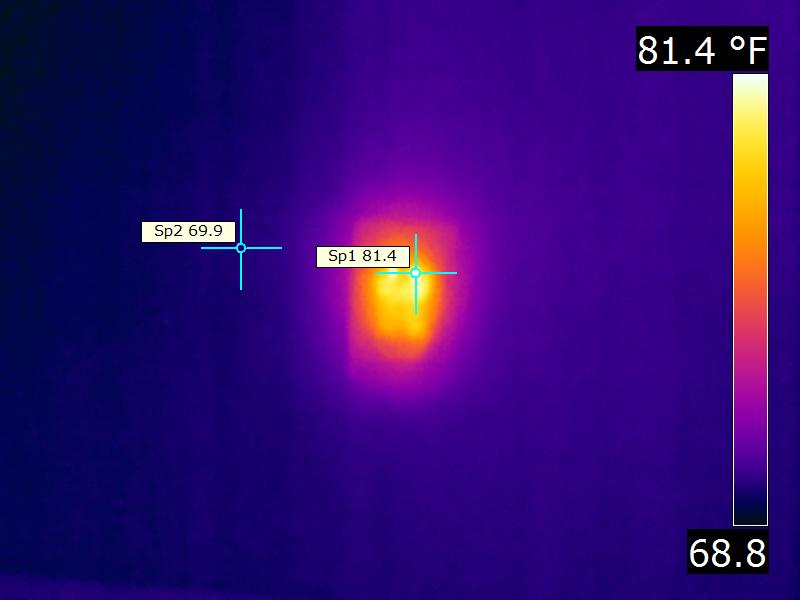I was headed into a bathroom to check a shower pan with the IR camera, and I just happen to hit the wall near the entry door to the bathroom the electrical outlet was indicating 11 degrees above its surrounding ambient. The outlet was not AFCI or GFCI the outlet had not been in use. Just a standard 3 prong outlet home constructed in 1988 and I have no clue why this outlet has an elevated temp
Not a AFCI outlet but thanks anyway. Those guys at that chat board are just a bunch of wise guys I don’t have time for.
It looks like the top half of the receptacle is hotter than the lower half…do I see white where the hot, neutral slots are? Resistance causes heat…maybe a loose conection either wire around the screw or a poor stab-lok. Odd that it’s warm with nothing plugged in…there’s no draw ya know. As a guy who has installed many a receptacle…sometimes you get a bad one, it happens.
No the image was a bit out of focus hard to focus on a wall with nothing to compare to. That was what the puzzel is about there is no load (amp) on the outlet no reason for the outlet to be nothing but the same temp as the wall
If the outlet was upstream of a dimmer, would it have a load on it? Guessing.
Maybe this circuit serves other lights/receptacles w a load on it. It just runs through this receptacle. I would check the amp draw on this circuit at the panel and if that is ok I’d then remove this outlet, pig tail the wires and slap in a GFI. Thats all I got, good luck.
More than likely it is caused by a loose connection on the binding screws of the receptacle. This is due to the way receptacle circuits are wired in residential construction. This receptacle is part of a circuit that has additional receptacles downstream. This means that there are wires landed on both binding screws on each side of the receptacle, and as such, current passes through the bonding links between each screw and on to the next downstream device.
BTW, wiring receptacle circuits is this manner is prohibited in commercial or industrial occupancies. The main reason for this is that if any connection fails, all downstream receptacles are effected.
Bill what you are saying makes sense this outlet was in a master bedroom and I don’t remember what might have been operating down stream perhaps a clock or some other small device I was the only person in the home at the time I discovered this outlet by accident
No real need to install a GFCI to resolve this issue. It is simply a matter of increased resistance caused by a connection issue. Repairs are not a part of home inspections.
However, repairing it would be a matter of removing power, drawing the receptacle out far enough, and check the connections. If found loose, examine the receptacle for damage. If it is not damaged, retorque connections and reinstall.
It is almost impossible to pigtail receptacles in residential wiring systems. The receptacle outlet boxes are normally of very limited volume and do not have sufficient room for pig tailed connections. Also keep in mind that the binding screws for the wires can actually be loosened as the receptacle is pushed back into the outlet box.
My mistake, I thought that you mentioned that it was a AFCI.
Must have had a senior moment…
That was my problem I went stark raving brain dead
Nice to met you in Vegas wish we could have talked more:D
Same here Charley, but the Pope was within an ear shot which meant no blasphemies…![]()
What is the temp rating (Hi & Lo) for the particular receptacle per the manufacturer?
